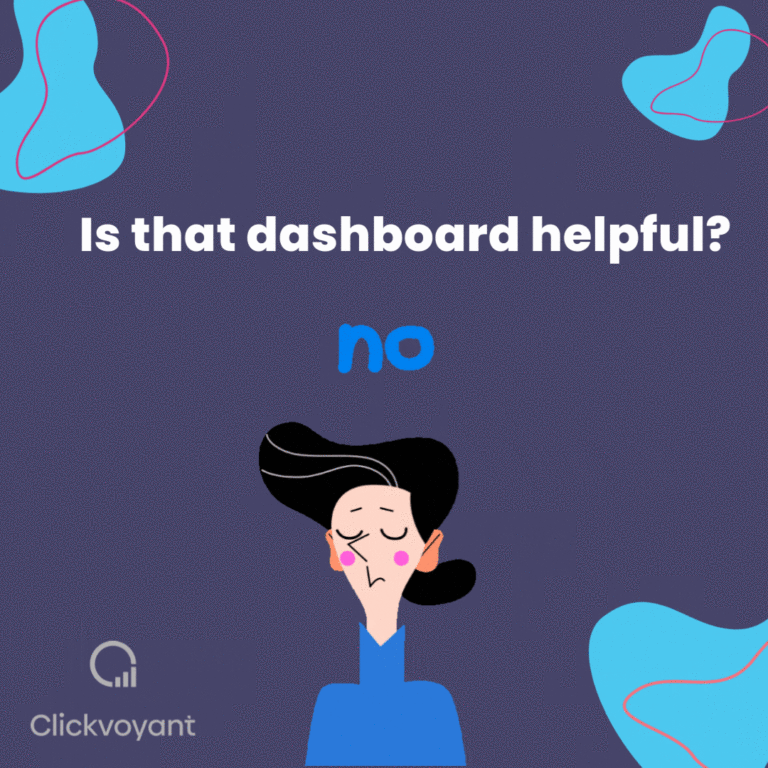Running a business can be tough. There’s so much to keep track of and different aspects that affect the success of our company.
Luckily, we have dashboards which allow us to manage all these issues efficiently and keep track of what is going on behind the scenes. We collect data from different sources and display it in pretty charts, tables, or in other ways that can easily be understood by anyone regardless of their background knowledge of data or math. Right?
Heck NO.
Cameron Warren asks a difficult question in his recent post on the matter:
What legitimate changes in behavior have they made based on data?
If the answer is difficult to articulate, then your analytics are weak.
To 10x Analytics, Treat It Like a Product
Here are the main problems with dashboards I’ve found over 15 years in marketing analytics.
Dashboards Are a Myopic View of a Business
While dashboards are can provide a great deal of information in an appealing way – they lack crucial bits that would give the user a full understanding of what’s going on. The whole point of data is its ability to generate insights that inform every single decision. In order for the business decision to be successful, a detailed analysis of data should be preferred. Dashboards do not provide you with a complete picture you need to make informed marketing choices. In this regard, dashboards are useless and unable to even come close to providing us with enough information.
One flaw of typical dashboards is that they don’t provide enough information from different angles and perspectives – this may seem like an advantage when looking for dashboard simplicity, but if one wants accurate insights for decisions, then a dashboard is the wrong tool.
In addition, every dashboard is created by different people and as such every dashboard developer or analyst chooses what variables are most important to them… which is almost always too much for the end user. This can lead to an overabundance of information – causing confusion in the audience who will find it overwhelming and difficult to locate the information that suits her needs best.
And often, a dashboard chart is just the beginning of understanding what is actually happenning. For example, a graph illustrating monthly sales may display numbers for November of this year which are much higher than November of last year. Data analysis could reveal that this November had more weekends, (higher sales conversion rates), than previous Novembers.
This is just a simple riff example, but the point is, without a data analyst helping you dig in, a marketing manager may make incorrect conclusions about performance.
Today, just having data doesn’t give you a competitive edge anymore. It’s the quality of the research and analysis that is going to help marketers to increase their customer conversion rates.
Dashboards Are Full of Vanity Metrics
On the flipside of analyst-driven dashboard design, an analyst designing a dashboard can follow the wishes of the person who wanted it made.
Avinash Kaushik, author of Web Analytics: An Hour a Day, coined the term HiPPO (Highest Paid Person’s Opinion) to emphasize how people use what an authoritative person says when they don’t have enough data. In meetings where decisions need to be made but don’t have enough data or data analysis to make them, many times people turn to whoever has the most experience and power in the room – which often turns out to be the HiPPO. A successful meeting usually results from whatever decision he/she makes being taken for granted without questioning because everyone knows that this person is higher up than everyone else in terms of knowledge and authority.
This process inserts itself often into the dashboard design process at most corporations. I can’t tell you how many analysts have relented on what they thought was important vs. what the stakeholder thought was important. Often, the analyst is not wrong, but the dashboard is limited to what the stakeholder can reasonably absorb amidst the many demands of her daily responsibilities.
Nobody’s fault really. This just illustrates the complication of the limited capability of one dashboard. Stakeholder needs to make decisions. The dashboard is the tool of record. The dashboard can’t possibly inform all daily or even monthly strategy decisions because the medium is limited…. and so it goes.
Decisions Made from Dashboards Are Often No Better Than a Random Guess.
When doing data analytics, three features need to be kept in mind.
- The data describes past and existing events.
- The data can predict future events based on past data.
- A course of action can be described using that data.
Dashboards might provide insights appropriate for the first point, but lack in terms of providing insights that allow for feasible decision-making. It lacks context, and predictions within that context.
If you do not have enough information about how your current situation compares to others or how well a certain course of action might work for future circumstances, then those forecasts won’t suffice either – which means any decisions made would be left up to chance at best and pure guesswork at worst.
Dashboards Result in More Questions Than Answers
With everything mentioned so far, there seems to be enough support to say that while the dashboard provides you with some insight, it doesn’t actually provide you with any answers. At least not directly. Sure, if you’re looking at the dashboard from an untrained eye, then it appears like all your questions have been answered – but from a trained data analyst’s perspective, there might still be unsolved mysteries.
If marketers want to get the best out of their company’s dashboards and prevent costly mistakes as much as possible, they should hire employees who understand these types of charts without relying too heavily on guesswork into their meaning.
It is important for marketers looking for sustainable growth to find ways around issues through sharp insights derived from analysis rather than dashboards.
The Bad News is There are No Analysts to Hire
Right now, there is a $200 billion dollar gap in analytics talent. Not enough people to take all the available and budgeted jobs. That scarcity makes the analyst role expensive and competitive to hire. This creates a situation of the have and have-nots in business. With a third of enterprise roles unfilled, everyone else gets boxed out of talent. Businesses sized from small enterprise and down are left to DIY their own data analysis with junior staff or ancillary managers
Clickvoyant is a data analyst as a service that will empower the boxed-out businesses to kick ass at customer acquisition and intelligence speed, to the envy of large enterprise.
The platform ingests raw data from any customer platform with an API to turn it into statistically significant insights in a simple slide presentation. All the data modeling is done by our platform.
When this presentation is in the hands of someone not trained in statistics, we provide education in the speaker notes. So even a strategist can confidently present and explain how we arrived at these numbers. That creates a new kind of analytic job, one that can be based on domain expertise, unencumbered by the need for technical skills.
This process that would typically take weeks, now takes 10 minutes.
We built this to close the gap from dashboard to data-driven decision making.
In Taylor Brownlow’s Medium post, The Who, What & How of the Last Mile of Analytics, she rightfully points out the real problem of analytics programs and delivery.
“Seventy percent of enterprises view advanced analytics as a critical strategic priority, but only 10% actually believe they’re achieving anywhere near the full potential value of those analytics. What’s the source of that value realization gap? Well, we believe one of the biggest sources that we see clients struggling with is the last mile. That is the gap between great analytic output and actual changed behavior that creates value in the enterprise — whether it’s a frontline worker, a manager, or even a machine.” [1]
We’ll let you read her full story, but this last mile analytics delivery is what we’re focused on automating due to the analytics talent market deficiency. Get a free trial of our dashboard alternative here.

